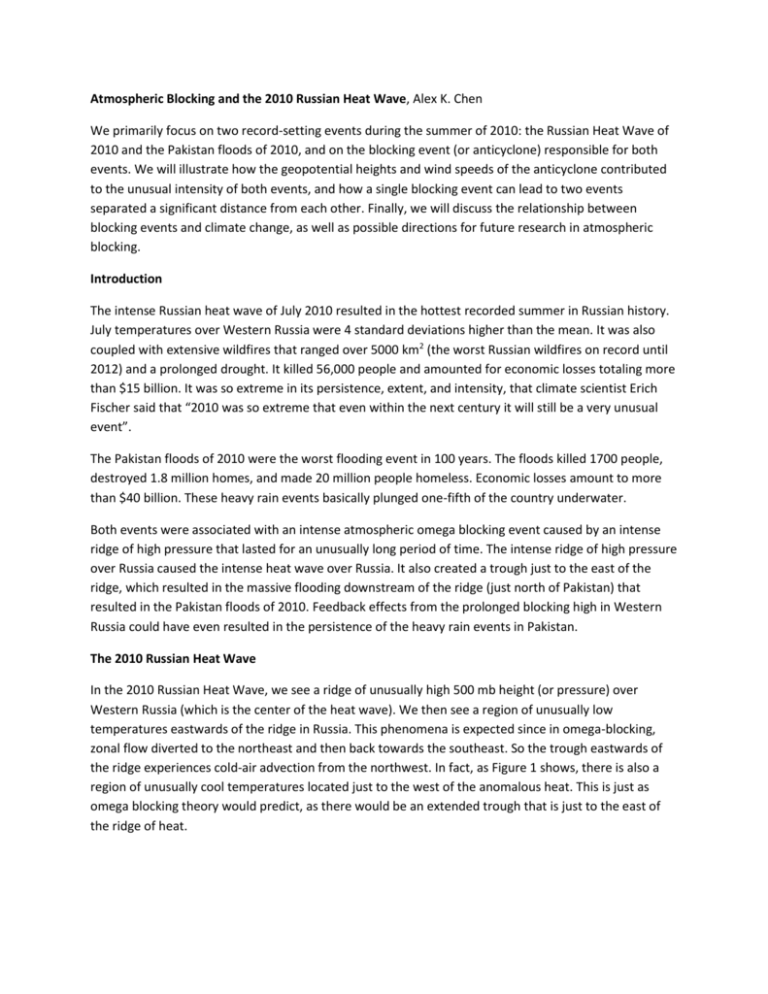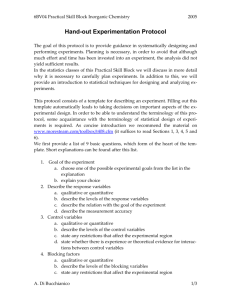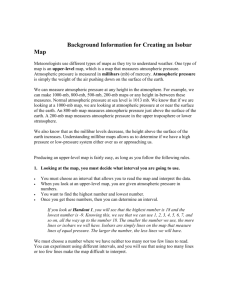Atmospheric-Blocking
advertisement

Atmospheric Blocking and the 2010 Russian Heat Wave, Alex K. Chen We primarily focus on two record-setting events during the summer of 2010: the Russian Heat Wave of 2010 and the Pakistan floods of 2010, and on the blocking event (or anticyclone) responsible for both events. We will illustrate how the geopotential heights and wind speeds of the anticyclone contributed to the unusual intensity of both events, and how a single blocking event can lead to two events separated a significant distance from each other. Finally, we will discuss the relationship between blocking events and climate change, as well as possible directions for future research in atmospheric blocking. Introduction The intense Russian heat wave of July 2010 resulted in the hottest recorded summer in Russian history. July temperatures over Western Russia were 4 standard deviations higher than the mean. It was also coupled with extensive wildfires that ranged over 5000 km2 (the worst Russian wildfires on record until 2012) and a prolonged drought. It killed 56,000 people and amounted for economic losses totaling more than $15 billion. It was so extreme in its persistence, extent, and intensity, that climate scientist Erich Fischer said that “2010 was so extreme that even within the next century it will still be a very unusual event”. The Pakistan floods of 2010 were the worst flooding event in 100 years. The floods killed 1700 people, destroyed 1.8 million homes, and made 20 million people homeless. Economic losses amount to more than $40 billion. These heavy rain events basically plunged one-fifth of the country underwater. Both events were associated with an intense atmospheric omega blocking event caused by an intense ridge of high pressure that lasted for an unusually long period of time. The intense ridge of high pressure over Russia caused the intense heat wave over Russia. It also created a trough just to the east of the ridge, which resulted in the massive flooding downstream of the ridge (just north of Pakistan) that resulted in the Pakistan floods of 2010. Feedback effects from the prolonged blocking high in Western Russia could have even resulted in the persistence of the heavy rain events in Pakistan. The 2010 Russian Heat Wave In the 2010 Russian Heat Wave, we see a ridge of unusually high 500 mb height (or pressure) over Western Russia (which is the center of the heat wave). We then see a region of unusually low temperatures eastwards of the ridge in Russia. This phenomena is expected since in omega-blocking, zonal flow diverted to the northeast and then back towards the southeast. So the trough eastwards of the ridge experiences cold-air advection from the northwest. In fact, as Figure 1 shows, there is also a region of unusually cool temperatures located just to the west of the anomalous heat. This is just as omega blocking theory would predict, as there would be an extended trough that is just to the east of the ridge of heat. Figure 1, from NOAA Timeline of the Russian Heat Wave Russia started to experience unusually warm temperatures from late May to early June. While these temperatures were not necessarily record-breaking, they helped dry out the soil, which only contributed to the intensity of the heat wave that was yet to come (this bears an interesting analogy with the record-breaking North American heat wave of July 2012, which owes much of its intensity to the recordbreaking warmth of March 2012 that dried out the soil over North America). The surface temperature over western Russia rose most significantly on June 20th, and remained high throughout the rest of the month. June 20th is often regarded as the beginning of the heat wave. After July 18th, the heat intensified and temperatures started to consistently exceed 8-10 degrees C above the normal mean values. This was when Moscow started to consistently hit stretches of days above 90F and exceeded 100F for the first time in recorded history. The Russian wildfires started on July 29th and ended on August 13th. The 2010 Russian Heat Wave finally ended on August 18, when a cold front brought rain to western Russia and ended the heat wave. In duration, it practically lasted for two entire months. Meanwhile, rains over Northern Pakistan started to episodically occur in mid-July, with clusters of intense rain events happening from the 11th-12th and the 19th-22nd. The heaviest rains came by July 27th29th. Atmospheric Blocking In the Northern Hemisphere, the Rossby Waves associated with the jet stream normally propagate from west to east. It often takes several days for the Rossby Waves to propagate across the United States. This is why we often get several bands of cold days followed by several bands of warm days. There are times, however, when the normal west-east progression of the Rossby Waves stagnates. This results in a phemonenon known as atmospheric blocking. Atmospheric blocking is one of the most poorlyunderstood phenomena in modern meteorology. It is not well-represented in either climate models or in forecast models, and there is still yet no consistent theory of atmospheric blocking (Croci-Maspoli 2005). As atmospheric blocks have extremely significant regional effects and can amplify the regional consequences of climate change, a better ability to forecast atmospheric blocking (and how it is affected by climate change) is imperative if we want to understand how climate change will affect different regions differently. Atmospheric blocking often happens when a particular ridge in the Rossby Wave stagnates for a period of time. This ridge of high pressure can then become “pinched” off from the normal west-to-east flow. Once an atmospheric block forms, it can either dissipate or persist. Persistence from atmospheric blocking can come from positive feedback associated with the region affected by the atmospheric blocking. This happens because when warm air goes over the region, much of the moisture is evaporated, and the area experiences a drought. Then due to the consistent heating, there is less surface moisture available that can then rise upwards to form clouds. Furthermore, there is increased air subsidence associated with geopotential ridges. So cloud formation is inhibited, which helps the soil stay dry for longer, which creates intense positive feedback effects (Lau and Kim, 2011). There are several types of atmospheric blocking, including omega blocks, rex blocks, and others. Omega blocking is the most well-known form of blocking, so this is the type of blocking that we will focus on. They are called “omega blocks” because the ridge of high pressure looks like an omega when surrounded by the two troughs of low pressure on the eastern and western flanks. Blocks are often referred to as “blocking anticyclones” because they are regions of high pressure that produce anticyclonic circulation around the high (or clockwise circulation in the Northern Hemisphere). The main distinction between regions of high pressure and regions of atmospheric blocking is that atmospheric blocking events tend to be very persistent. Now, why does atmospheric blocking prevent storms (and precipitation) from going west into the blocking region? This is because of the Coriolis Effect. Air parcels normally move from a region of higher pressure (like the region in the ridge) to a region of lower pressure. These air parcels are then diverted to the right by the Coriolis Effect. So around a ridge in the Northern Hemisphere, air parcels tend to be diverted in a clockwise direction. This also tends to deflect cyclones as well. In fact, Hurricane Sandy may owe its unusual trajectory to an atmospheric blocking event in the North Atlantic that prevented it from progressing eastwards as normal cyclones do. There are also other examples of atmospheric phenomena that are attributed to a certain kind of blocking. For example, the North Atlantic Oscillation is an index that can also predict a certain type of blocking over the Atlantic Ocean. When the NAO is strongly negative, there is an unusually small pressure gradient between the Icelandic low to the North and the Azores high to the south (this often happens when a ridge of high pressure forms over Greenland). The net result of this is that the high pressure system “blocks” the normal progression of ridges and troughs from west to east, which blocks the progression of storms and can result in unusual levels of persistence in stormy conditions in North America to the east of the trough. Negative phases of the NAO cycle also means that weather patterns from the north are forced southwards, which result in unusually cool conditions both upstream and downstream of Greenland – which includes both North America and Europe. In fact, an unusually negative phase of the NAO oscillation (see Figure 2) could have led to the unusually cold winter of 2009-2010 in Europe. Figure 2, from http://climatedataguide.ucar.edu/guidance/hurrell-north-atlantic-oscillation-nao-index-station-based The jet streams are strongest when the pole-to-equator temperature gradient is highest (this is because this tends to result in more meridional flow that then gets deflected zonally by the Coriolis Force, as can be calculated by the thermal wind balance). So they are usually strongest during the wintertime, when these gradients are at their highest. Nonetheless, the jet streams can still act like important waveguides for the Rossby waves over the summer, and that these boreal summer Rossby waves could explain anomalous events such as the July 2012 Russian Heat Wave (Schubert et al 2010). Blocking events can happen in both wintertime and summertime. Blocking events over the oceans tend to be more common in the winter, while blocking events over land tend to be more common in summer. It is possible that climate change could affect each blocking event differently. There are a number of climatological studies that cover the relative frequency of blocking events over ocean and land, which are beyond the scope of this paper. Theory The most widely used definition of atmospheric blocking comes from Tibaldi (1990), where GHGS is the geopotential height gradient to the south, and GHGN is the geopotential height gradient to the north. Blocking is satisfied when GHGS > 0 and GHGN < - 10m/deg latitude for at least one value of Δ, and usually for at least some range of longitudes. So when there is a ridge of high pressure (or geopotential height) and for Δ = 0, GHGS > 0 implies that the geopotential height at 60N must be higher than the geopotential height further south. GHGS < -10m/deg latitude means that the geopotential at 60N must not only be higher than the geopotential height further north, but that it must also increase at a rate greater than 10m/deg latitude. Despite its widespread use, however, the Tibaldi definition is not a particularly constructive definition, as it gives little information about how we could compare the relative intensities of different atmospheric blocking events. Furthermore, the definition assumes that blocks are centered at a narrow range of latitudes around 60N, and that for a block to happen, the geopotential height must be compared to the geopotential height 20 degrees to the north and the geopotential height 20 degrees to the south. The advantage of this constraint is that it gives us consistent way of measuring blocking and allows us to construct a blocking index on a longitude-vs-time frame, known as a Hovmoller diagram. One of these indices can be seen on the NOAA website, as depicted by Figure 3. Figure 3, from http://www.cpc.ncep.noaa.gov/products/precip/CWlink/MJO/block.shtml But this is an extremely simplistic way of measuring blocking, as it treats each longitude as equivalent, when this clearly isn’t the case. There are some longitudes that are mostly ocean-covered, and some longitudes that are mostly land-covered. But do these longitudes really have to be treated as equal to each other? What if GHGS > 0 as compared with 16 degrees to the South, but GHGS = 0 when compared with 20 degrees to the South, as an example? There have been attempts to construct alternative indices of atmospheric blocking (as discussed in Croci-Maspoli 2005), but even these alternative indices of blocking have their own imperfections. It suffices to say that this is one of the most promising areas in climate science for significant breakthroughs. The Anticyclone Responsible for the Russian Heat Wave Figure 4 measures the number of blocking events at each longitude as according to Tibaldi (1990)’s criterion. It shows that this blocking event was the result of the block shifting 10 degrees to the East of where it usually occurs. The number of blocking events far exceeds the number of blocking events that would happen even if the number of blocking events were 2 standard deviations higher than the mean. Figure 4 (from Lau et al. 2011) In this section, we will take two diagrams of the anticyclone from Lau et al. 2011, and try to see if these diagrams satisfy the criterion given by Tibaldi 1990. Lau et al. 2011 defines two periods of the atmospheric blocking event. Period 1 is from July 10 to July 24. Period 2 is from July 25 to August 8. Period 2 is the period of time associated with the most extreme consequences (the Russian Heat Wave, Moscow breaking 100F for the first time, and the Pakistan floods). Both are shown as Figure 5 below. Figure 5 In the top diagram of Figure 5 (corresponding to the first phase of the anticyclone as defined by Lau 2011), the ridge of high pressure (slightly above 5850 m) is centered at around 56N, and covers a longitudinal span from 30E to 40E. It is actually impossible to directly apply Tibaldi (1990)’s criterion to the diagram above, as we do not have a precise view of what is going on at 76N. We can see, however, that the geopotential height at 70N is 5610 m. This means that GHGN = [Z(Φ0)-Z(70N)]/14 = 17m/degree latitude (which is under the -10m/degree latitude needed). As the decline in GHGN is fairly slow around 56N, and fairly rapid around 70N (due to the tightly-packed contours at 70N), GHGN will most likely even be more negative at 76N. For GHGS, however, we see a geopotential height that is just barely under 5850m at 36N. So while GHGS = Z(Φ0)- Z(Φs) > 0, it really only barely satisfies the criterion of blocking. So the blocking anticyclone responsible one of the most legendary examples of atmospheric blocking really only barely satisfies the Tibaldi (1990) criterion of atmospheric blocking, which should give an illustration of some of the flaws associated with this criterion. We should keep in mind, however, that these diagrams correspond to the pressure fields averaged over time, so it possible that the blocking was more intense during some days and less intense during other days. The bottom diagram of Figure 5 corresponds to period 2 of the anticyclone. Its center has migrated eastwards from 35E to 47E (which corresponds to a phase speed of around 1104 km in 10 days, or 110 km/day). Its longitudinal span ranges from 39E to 55E. As a reference, Moscow is at 55.8N, 37.6 E. Period 2 of the anticyclone corresponds to the worst phase of the Russian summer heat (when Moscow was basically hitting record highs every day) and also to the massive Pakistani floods. From period 1 to period 2, we also see an intensification in the downstream trough of the anticyclone, as the trough bends more sharply to the South over Pakistan. We also see an intensification of the 200 hPa wind speeds, although the 200 hPa wind speeds are most intense downstream of the anticyclone, rather than around the anticyclone. The ridge of high pressure is slightly above 5880 m, so we can see that the ridge of high pressure has intensified. Z(70N) = 5730m So [Z(56N)-Z(70N)]/14 = -10.7m/degree latitude. This number is most likely more negative at 76N. GHGS, meanwhile, is clearly negative (although only by one 30m contour line). So phase 2 of the Russian anticyclone also was an atmospheric block as defined by Tibaldi (1990). It is also interesting to note that the most intense negative temperature anomalies during July (as observed on Figure 1) were between 70E and 80E. This basically corresponds to the region right in between the blocking high to the west and the trough to the east as depicted by Figure 5. Figure 6 The anticyclone also resulted in its pattern of wind and precipitation anomalies, as shown by Figure 6 (red regions correspond to regions of negative precipitation anomalies and blue regions correspond to positive precipitation anomalies) – taken from Lau et al 2011. It is easy to see the intense clockwise geostrophic circulations around the high-pressure ridges. As the pressure gradients are low in the middle of the ridge, there is little geostrophic wind speed in the ridge’s center, which basically means that there is stagnation in the high pressure region. This stagnation could have contributed to the especially poor air-quality levels in Moscow that happened along with the heat wave. As GHGS > 0 by definition, we expect the anticyclonic (clockwise) circulation to continue on south of the ridge. But since GHGS is weaker than GHGN, we would expect this anticyclonic circulation to weaken south of the ridge. As there is little weakening in the flow south of the ridge, there seem to be ageostrophic effects south of the ridge that help maintain the anticyclone’s intensity. This effect is especially interesting because it shows northeasterly flow. Northeasterly flow simply isn’t the type of flow that one would expect to be very common, except in the case of cut-off highs. The consistent intensity of the anticyclonic wind speeds around the entire ridge of high pressure also implies little warm-air advection from the south. So it appears that heat advection from the south does not seem to contribute to the intensity of the Russian heat wave. This is especially important to note given the extreme persistence of the Russian heat wave. As the spacing of the contours are closest some distance away from the ridge, this means that the pressure gradients were also most intense some distance away from the ridge. The high-pressure ridge was co-existent with a low-pressure trough just to the east of the ridge (the existence of this trough is consistent with what should be expected from omega-blocking). There should be cyclonic (or anticlockwise) circulation of air around this trough, which could perhaps result in especially intense northerlies in between the ridge and the trough, which could have brought in the cold air that triggered the Pakistan floods. Do we observe these intense northerlies in the figure? It’s hard to see if these northerlies were more intense than the circulation around the other parts of the ridge. These winds significant amounts of northerly extratropical air into Pakistan, which, when mixed with southerly air from the Indian Ocean, caused the Pakistan floods. The anticyclonic circulation associated with the ridge brought cooler air and intense northerlies from western Siberia to regions further south, like Iran and even Pakistan. The large amount of cold (sinking) air collided with warm rising air from the Bay of Bengal, which created huge temperature and moisture gradients that was favorable for the development of monsoons. The persistence of this anticyclonic pattern made the monsoon rains over Pakistan unusually persistent. Discussion and Conclusion While much of the literature has given us a very good picture of what happened during the blocking event, there are still large unknowns on how the blocking event formed and why it persisted far longer than most other atmospheric blocking events. While there are many theories of cyclogenesis, there simply seem to be far fewer theories on the genesis of atmospheric blocks. A better understanding of atmospheric blocking is one of the most important things to understand if we want to understand the future of a warming Earth. There is still significant debate over whether or not atmospheric blocking can be tied in with climate change, as well as whether or not the 2010 Russian heat wave was the result of climate change. Some papers, like Dole et al. 2011, argue that despite its unprecedented temperatures, the 2010 Russian heat wave was still a result of natural variability (as there actually was no trend towards increased summertime temperatures in the region affected by the heat wave). While a better empirical understanding of atmospheric blocking can be obtained by simply waiting for more events like the 2010 Russian Heat Wave to happen, this should only persuade us to further better understand the theory behind atmospheric blocking so that we do not have to analyze these events only after they happen. And as extended heat waves represent some of the worst aspects of climate change, it only makes it more imperative for us to understand atmospheric blocks so that we can better understand what heat waves in the future will be like. While the 2010 Russian heat wave was a 4-sigma event compared to climatology, would it still be a 4-sigma event in a warming world? Could North America experience sustained heat waves far worse than the legendary heat waves of July 1936 and July 2012? Why isn’t atmospheric blocking captured very well in climate models? This could be a result of feedback processes, especially those associated with both clouds soil moisture effects. It is known from the Russian heat wave that the heat wave’s persistence and intensity was partially due to feedback effects from decreased soil moisture, which also resulted in the reduction of cloud cover. Since interaction with soil moisture and clouds are some of the most poorly resolved features in climate models, this could be one of the reasons why it is so difficult to simulate atmospheric blocking in both weather forecasts and climate models. There are still many important variables we must understand in order to better understand atmospheric blocking. If climate change is associated with atmospheric blocking, for example, could one believe that its effects on atmospheric blocking would be stronger in winter than in summer? Or would its effects on atmospheric blocking be weaker in winter than in summer? If a warmer planet means that the jet stream will move northwards, will this change the occurrence of atmospheric blocking events in the Arctic regions, as compared with regions south of the 40th parallel? Would it also increase the standard deviation in temperatures, as there could presumably be an increased frequency of especially-warm winters and especially-cold winters? Would this frequency change as we changed the timestep of each month? (if we said that each month was 15 days rather than 30 days, for example?) Furthermore, how does the wavenumber of the Rossby Waves affect atmospheric blocking? The Southern Hemisphere has a lower Rossby Wavenumber than the Northern Hemisphere. What would this, in turn, say about the occurrence and frequency of blocking events in the Southern Hemisphere, as compared with the Northern Hemisphere? What can paleoclimatic proxies tell us about the extent of atmospheric blocking in earlier timeperiods, like the Last Glacial Maximum and during the Eocene Hothouse period? In order for theory to better understand blocking, one could use idealized simulations to test blocking. For example – how is blocking affected by air-sea heating contrasts in the mid-latitudes? Would atmospheric blocking be different in a world with a Pangaea-like continent, as compared to a world with a modern-day continental configuration? How would the number and intensity of blocking events change on an Earth that rotates more slowly than it does today? And if this is the case, would the effects primarily be due to the changed scope of the Coriolis Force, or could they also be affected by the changed nature of diurnal heating contrasts? Finally – is atmospheric blocking known to occur in the atmospheres of other planets, like Jupiter and Mars? References Dole, R., M. Hoerling, J. Perlwitz, J. Eischeid,P. Pegion, T. Zhang, X.‐W. Quan, T. Xu, and D. Murray (2011), Was there a basis for anticipating the 2010 Russian heat wave?,Geophys. Res. Lett., 38, L06702 Lau, William K. M., and Kyu-Myong Kim 2011. The 2010 Pakistan Flood and Russian Heat Wave: Teleconnection of Hydrometeorological Extremes. Journal of Hydrometeorology. 13-1, 392–403. Croci-maspoli, Mischa 2005. Climatological Investigations of Atmospheric Blocking - A Dynamically-based Statistical Analysis. no. 16151 Siegfried Schubert, Hailan Wang, Max Suarez. (2011) Warm Season Subseasonal Variability and Climate Extremes in the Northern Hemisphere: The Role of Stationary Rossby Waves. Journal of Climate 24:18, 4773-4792 Tibaldi, S.; Molteni, F. 1990. On the operational predictability of blocking. Tellus Ser. A-Dyn. Meteorol. Oceanol. 42A, 343–365.






